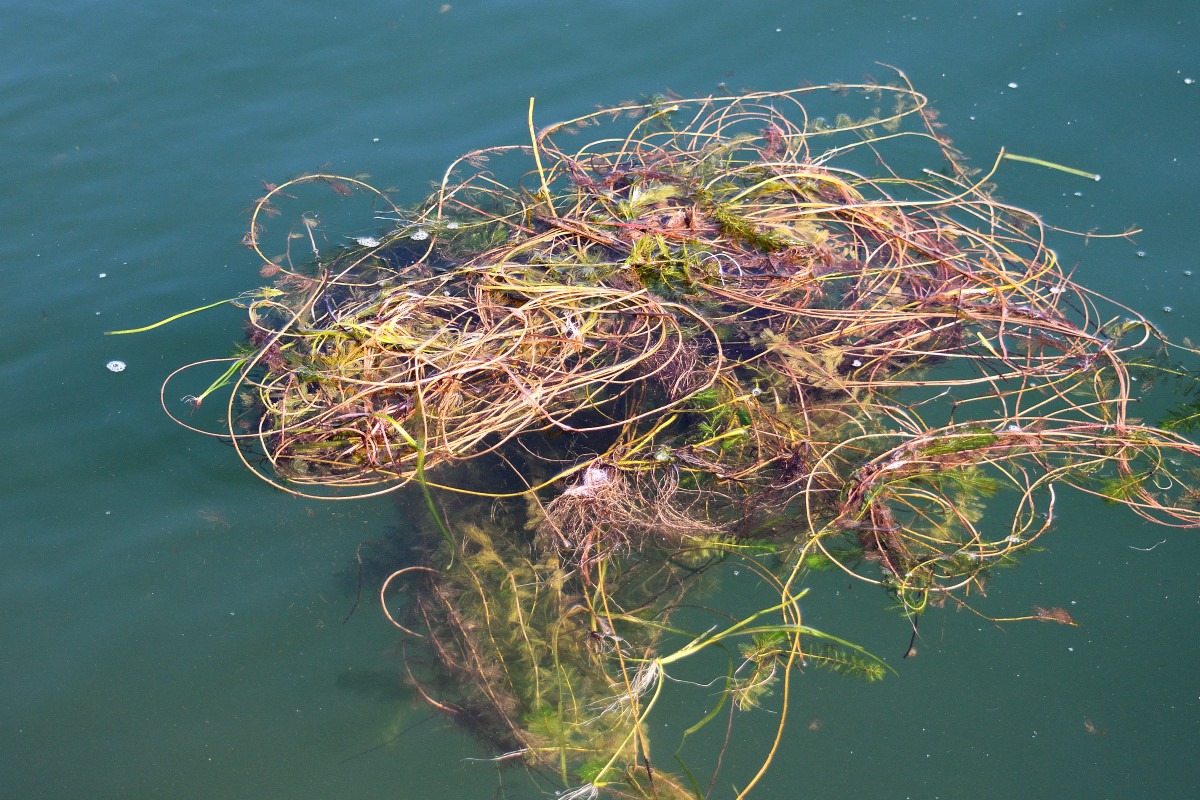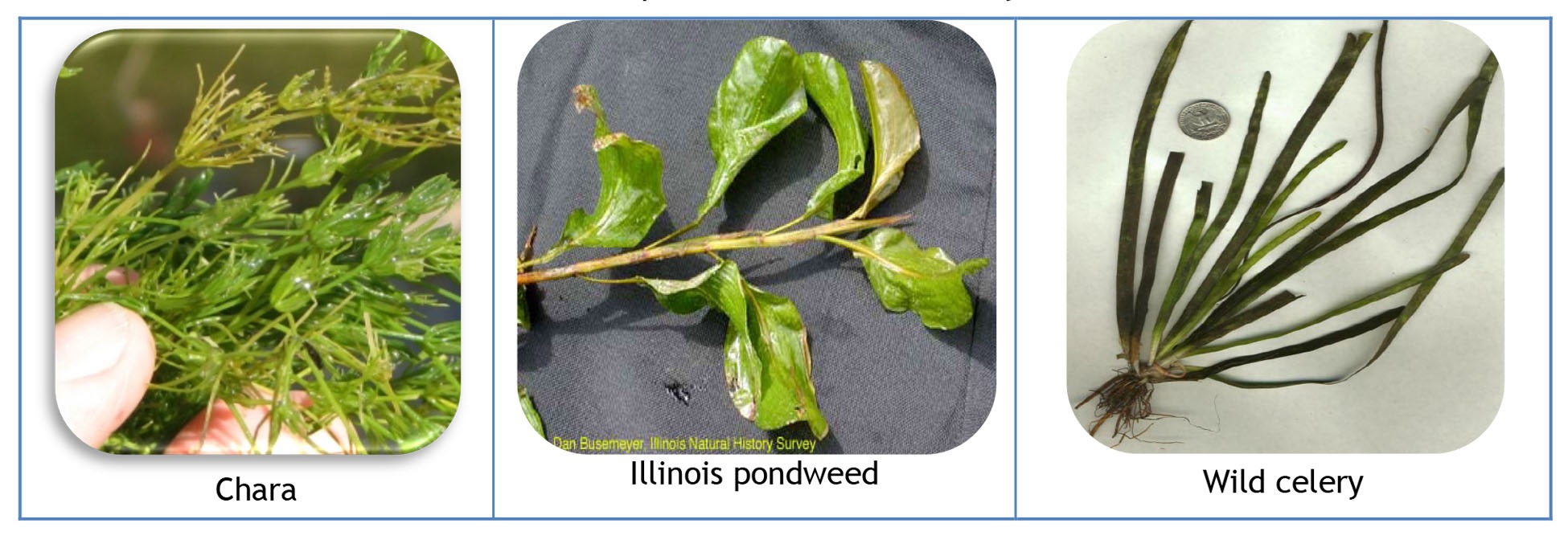PLM surveys Clark Lake for invasive weeds in the spring and fall. Based on data gathered, they prepare a comprehensive report on current conditions; and from that, outline a treatment program for next year. The fall 2022 survey illustrates the progress achieved in the battle against invasive species. Hybrid Eurasian water milfoil (HEWM) was found in only two locations, both near the County Park at the east end. That’s no surprise. If HEWM is to be found in Clark Lake, it will certainly show up there. On the upside, past surveys revealed sections of HEWM infecting other areas as well. Only two spots showing can be considered a win.
 HEWM was first documented to be in Clark Lake in 2014. The growing nuisance had been around before that, but it was then that the scientific testing of samples confirmed the bad news. Invasive weed growth was accelerating as HEWM enlarged the areas it covered, and simultaneously moved into other vulnerable areas. What started as the annoyance of fouled props and ugly floating patches, was fast turning into a threat. A committee of Clark Lake residents formed to determine what could be done to defend the lake from this invader. As the result of their work, and with overwhelming support of residents, a special assessment district (SAD) was established through Columbia Township. Through the SAD, treatment could be applied anywhere in the lake HEWM was found, and the expense of treatments could be adequately defrayed.
HEWM was first documented to be in Clark Lake in 2014. The growing nuisance had been around before that, but it was then that the scientific testing of samples confirmed the bad news. Invasive weed growth was accelerating as HEWM enlarged the areas it covered, and simultaneously moved into other vulnerable areas. What started as the annoyance of fouled props and ugly floating patches, was fast turning into a threat. A committee of Clark Lake residents formed to determine what could be done to defend the lake from this invader. As the result of their work, and with overwhelming support of residents, a special assessment district (SAD) was established through Columbia Township. Through the SAD, treatment could be applied anywhere in the lake HEWM was found, and the expense of treatments could be adequately defrayed.

As HEWM multiplied rapidly, the committee’s research uncovered some scary scenarios if no effective battle was enjoined. Lakes that didn’t act paid the price in diminished recreational uses, harm to natural habitat, and reduction in property values.
The full-lake Sonar treatment of 2019 was a big win for Clark Lake. Of all treatment efforts, it took out the most HEWM. When will the fight end? Clark Lake is a public lake, and boaters from elsewhere visit it often. If a boat has been in an infected lake, those visitors can reintroduce HEWM and/or other nasty invasive species. That’s Clark Lake’s primary vulnerability. Other lakes have it worse. When a stream flows into a lake, it’s a perfect transfer point for invasive plants to find new homes. Clark Lake’s water level is replenished by its 150 springs and rain. No stream empties into the lake, and water only exits through the dam at Ocean Beach.
 Over the last couple of years, another invasive specie showed up. Starry stonewort was found in two locations–at Eagle Point and at the east end of the lake. Although Starry looks like a weed, it’s actually classified as an algae. It can grow up to 7 feet, and has created havoc in some Michigan lakes, including nearby. PLM treated both locations at Clark Lake in the past. The good news? None was found in the survey this fall. Commenting on HEWM and Starry, PLM writes both “species are notorious for displacing native plant species and altering aquatic habitats. The native plant species in Clark Lake benefit the lake, performing such functions as stabilizing sediments and providing habitat for fish and other aquatic organisms. In general, native species cause few problems, compared with those caused by exotic plants.”
Over the last couple of years, another invasive specie showed up. Starry stonewort was found in two locations–at Eagle Point and at the east end of the lake. Although Starry looks like a weed, it’s actually classified as an algae. It can grow up to 7 feet, and has created havoc in some Michigan lakes, including nearby. PLM treated both locations at Clark Lake in the past. The good news? None was found in the survey this fall. Commenting on HEWM and Starry, PLM writes both “species are notorious for displacing native plant species and altering aquatic habitats. The native plant species in Clark Lake benefit the lake, performing such functions as stabilizing sediments and providing habitat for fish and other aquatic organisms. In general, native species cause few problems, compared with those caused by exotic plants.”
What are other weeds commonly found in higher densities at Clark Lake? One is Chara that looks a lot like Starry stonewort. Unlike Starry, it doesn’t pose the same threat. Other common weeds in Clark Lake are Illinois pondweed and wild celery. The weed program only targets invasive plants because of their threat.

PLM also monitors water quality. Measures quantified are water clarity; temperature and dissolved oxygen profiles; dissolved solids, pH and alkalinity; total phosphorous; and nitrates. PLM notes “water quality monitoring provides an ongoing record of conditions in a waterbody. Changes in water quality can indicate threats from sources such as failed or inadequate septic systems, agricultural and lawn runoff, burgeoning development and erosion from construction sites. Prompt identification of threats to water quality makes it possible to remedy them before irreversible harm has been done.” Comparing data in previous reports, no significant changes have taken place with Clark Lake’s water quality, and results appear to be well within expectations for our kind of lake.
PLM is recommending the following treatment plan for 2023.
- A spring vegetation survey (to evaluate conditions in the lake and direct management efforts)
- Water quality monitoring should continue
- Early summer herbicide treatment (to control any Eurasian watermilfoil and/or Starry stonewort areas that are found)
- Mid summer herbicide treatment, if required
- Mid-summer water quality sampling
- Late summer herbicide treatment, if required
- A fall vegetation survey
- Fall water quality sampling
The cost of these actions can easily be accommodated using the current assessment program in place.
Click here to view a PDF of the fall report.
An entire section of this website is devoted to the threat of invasive weeds at Clark Lake. Click here for more.











Hi Rick. Thank you for an excellent explanation of the water quality of our lake. Seemed to me that the lake was the “clearest” ever this year. Looking forward to some warmer weather on our very special ClarkLake. Happy New Year to you, Rick, and all of the ClarkLakers.